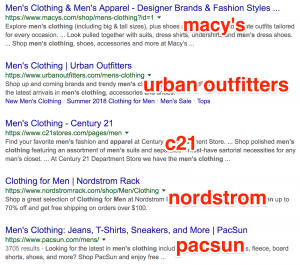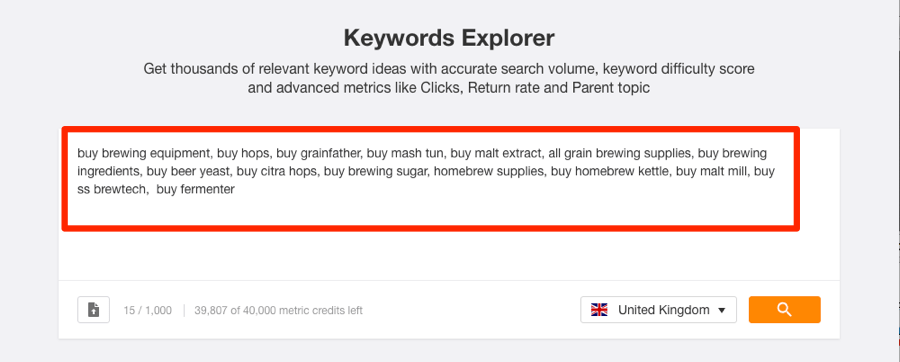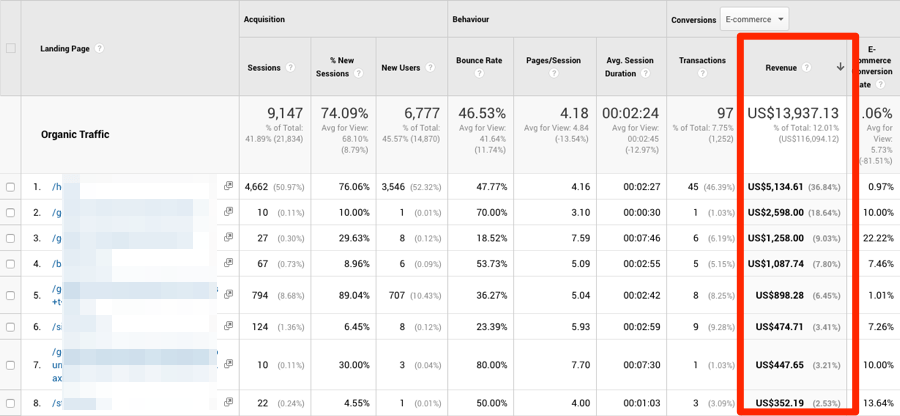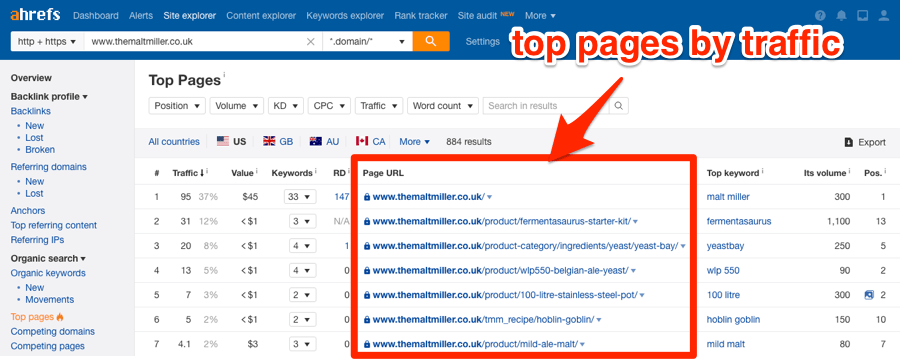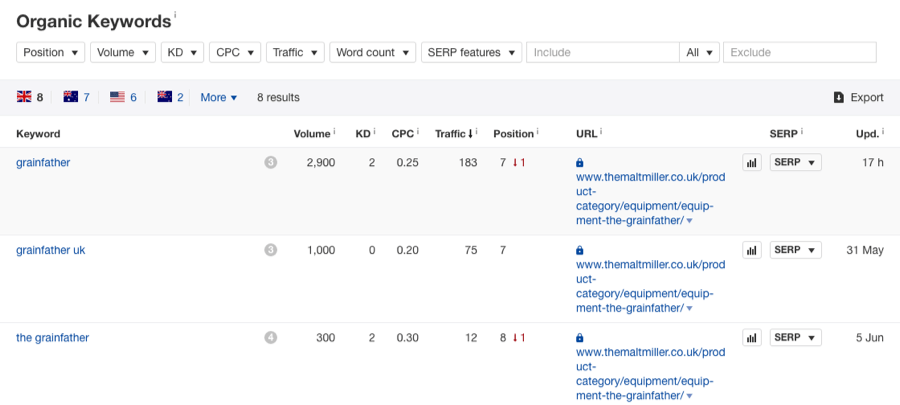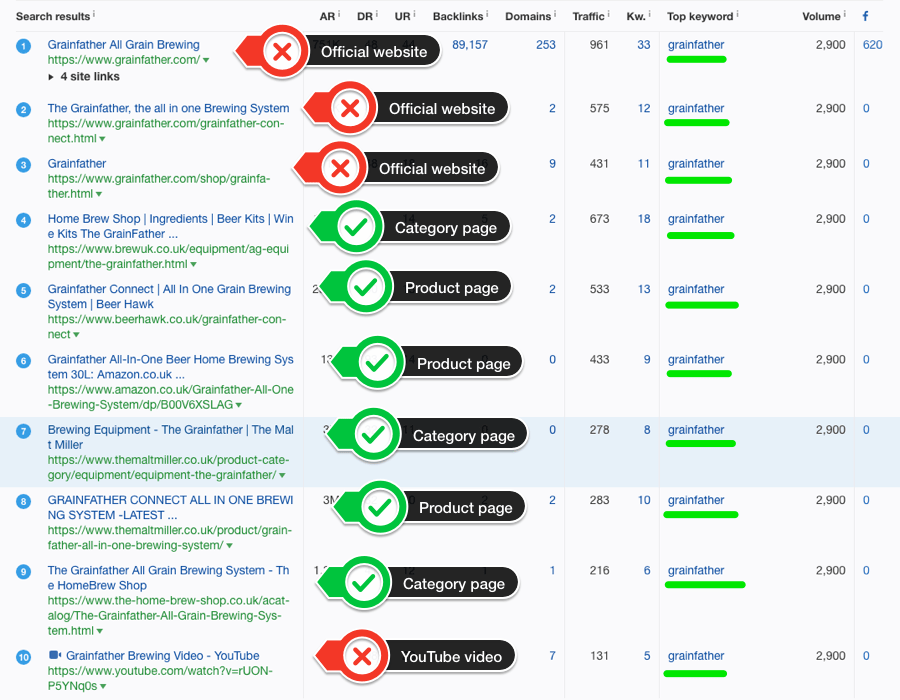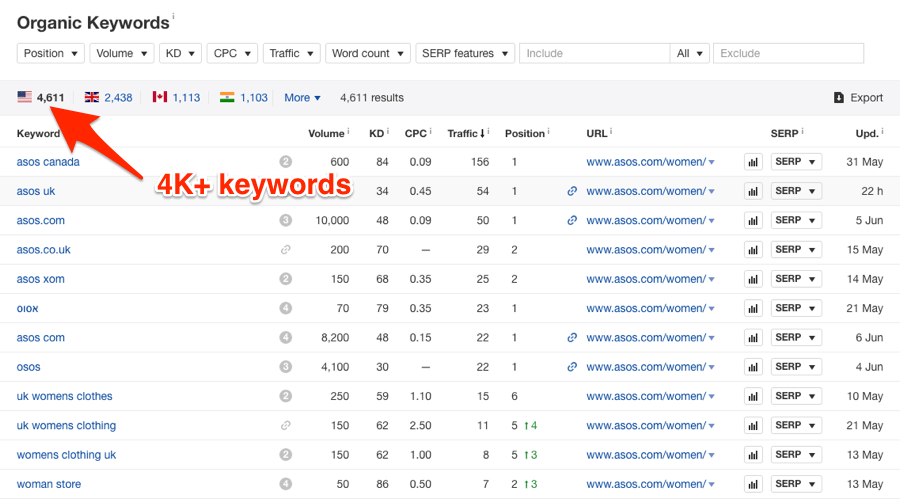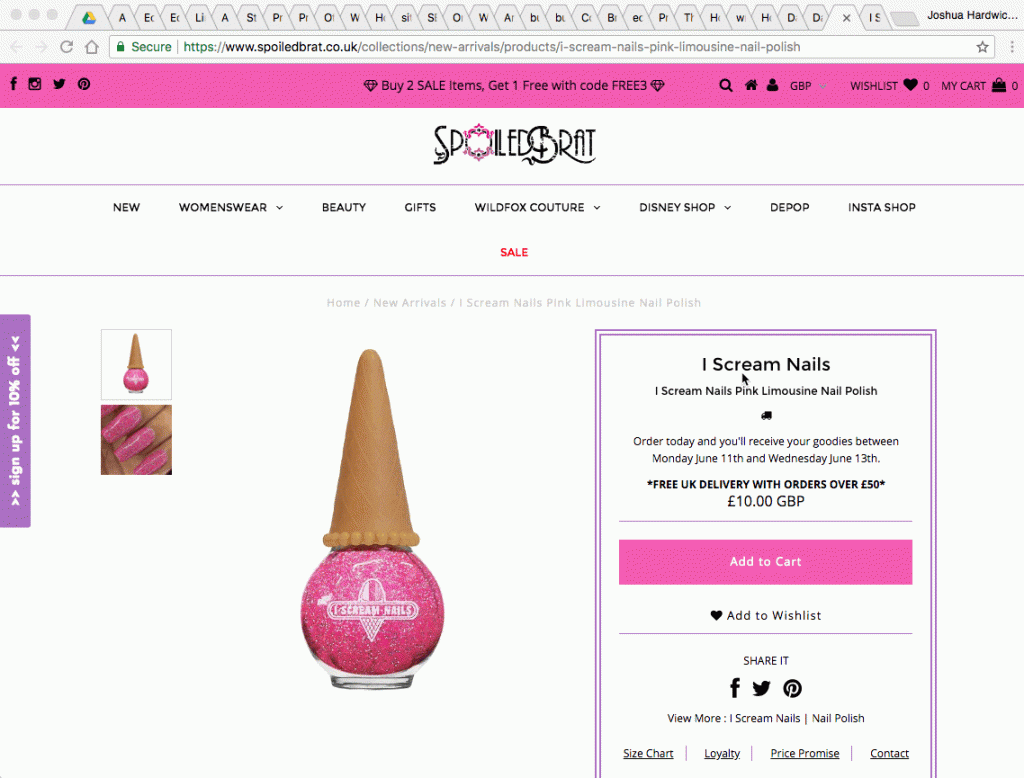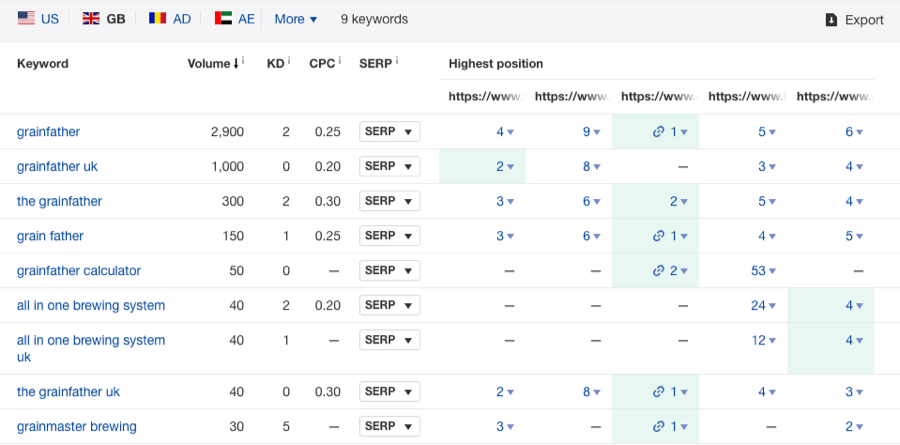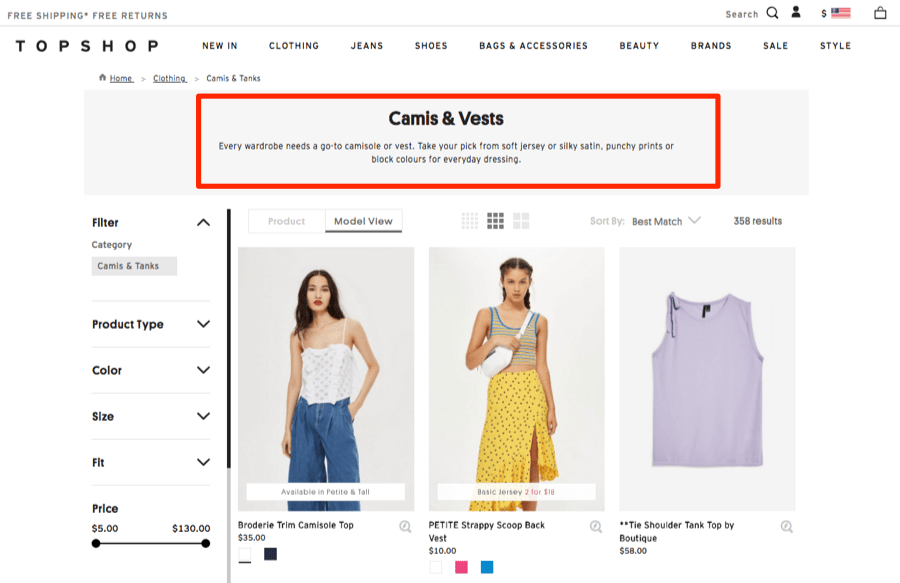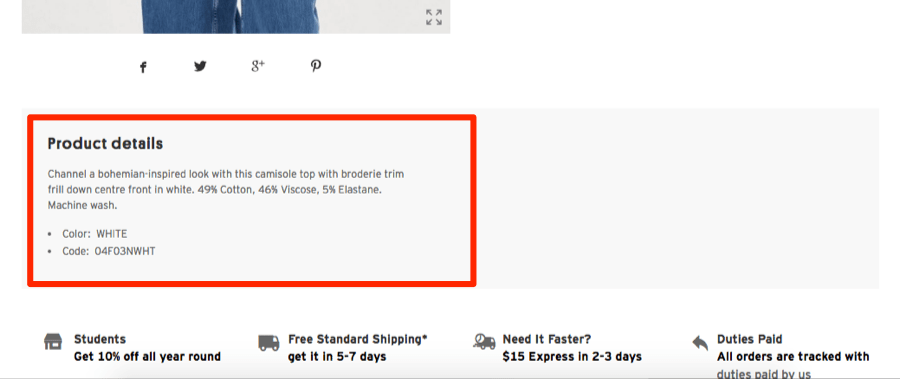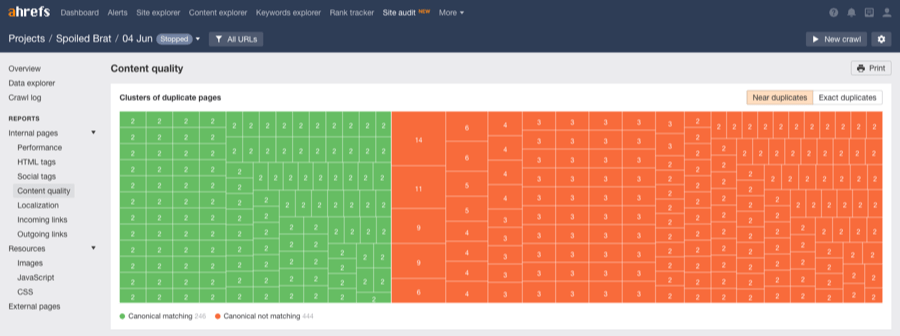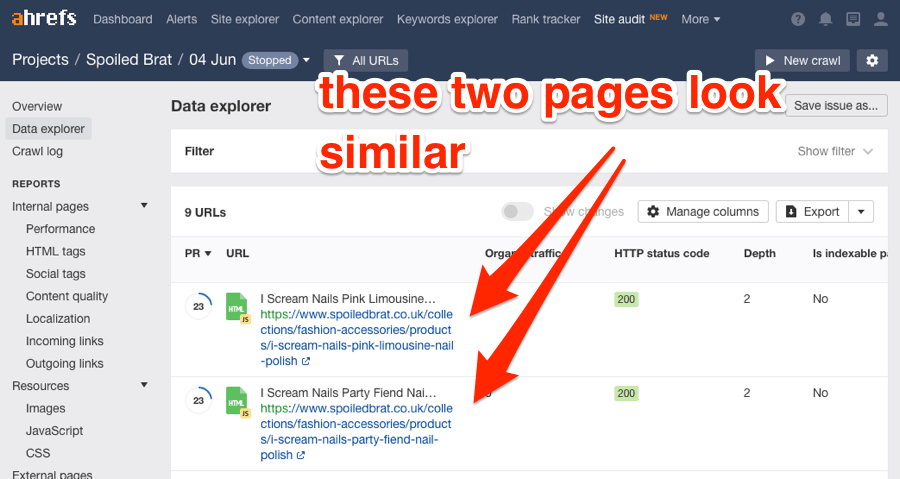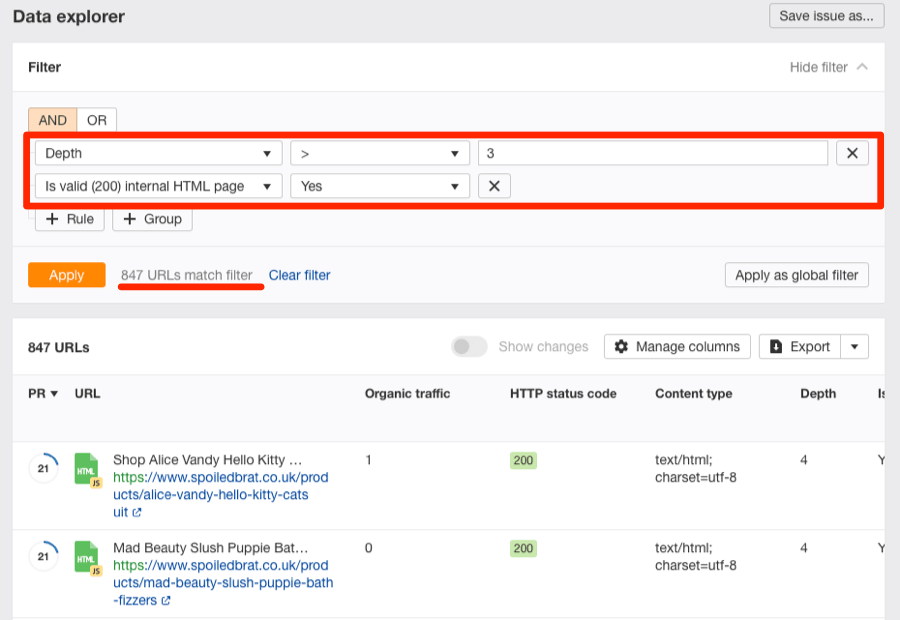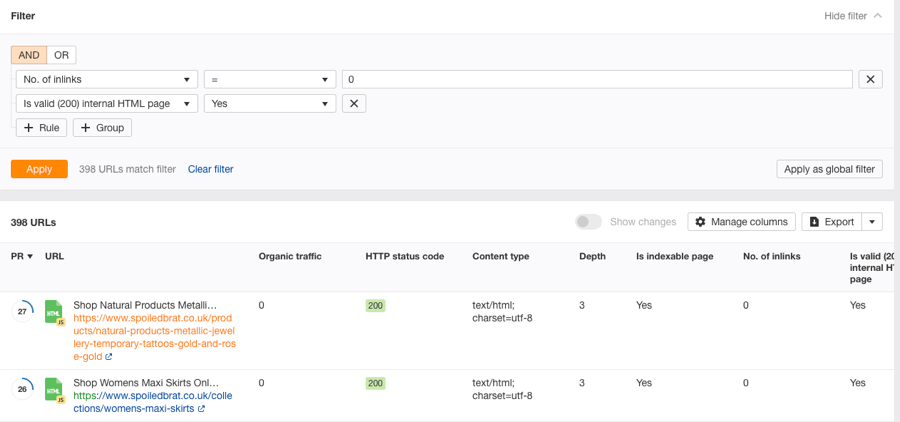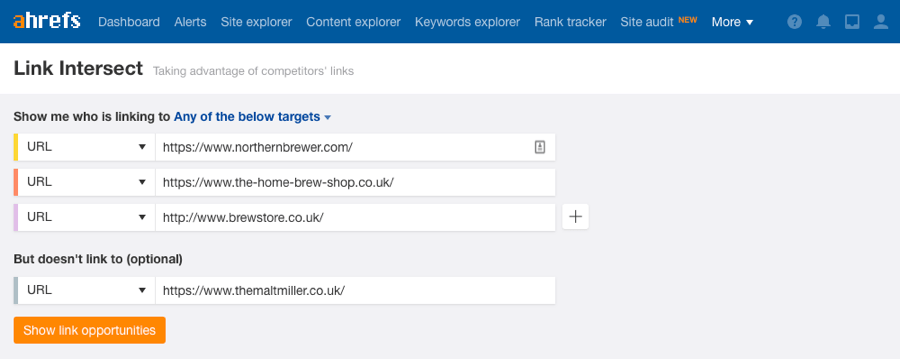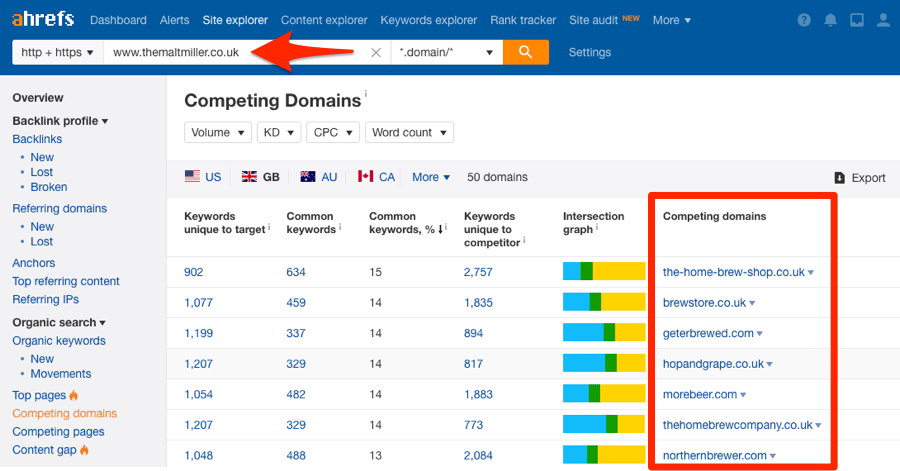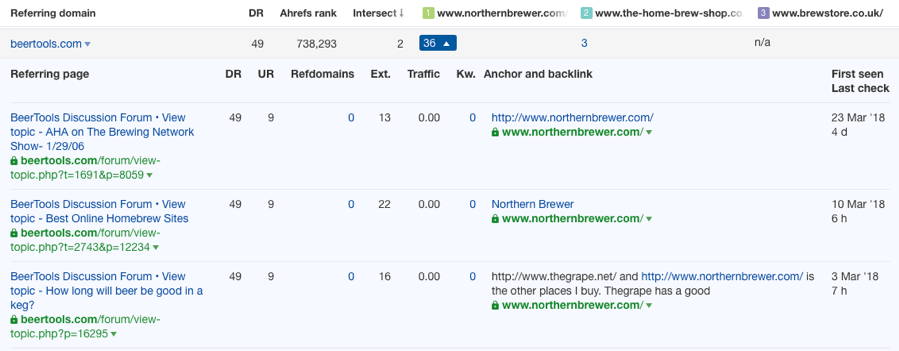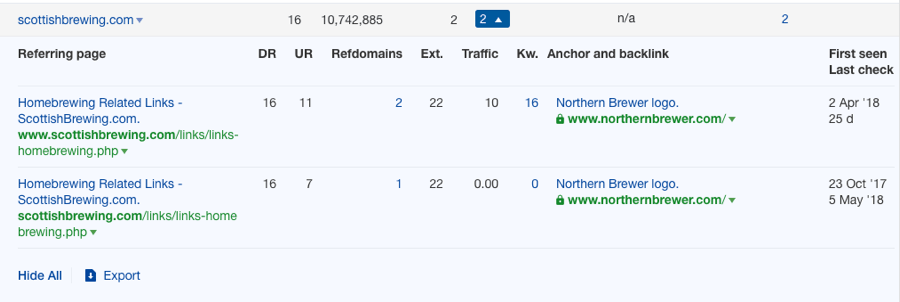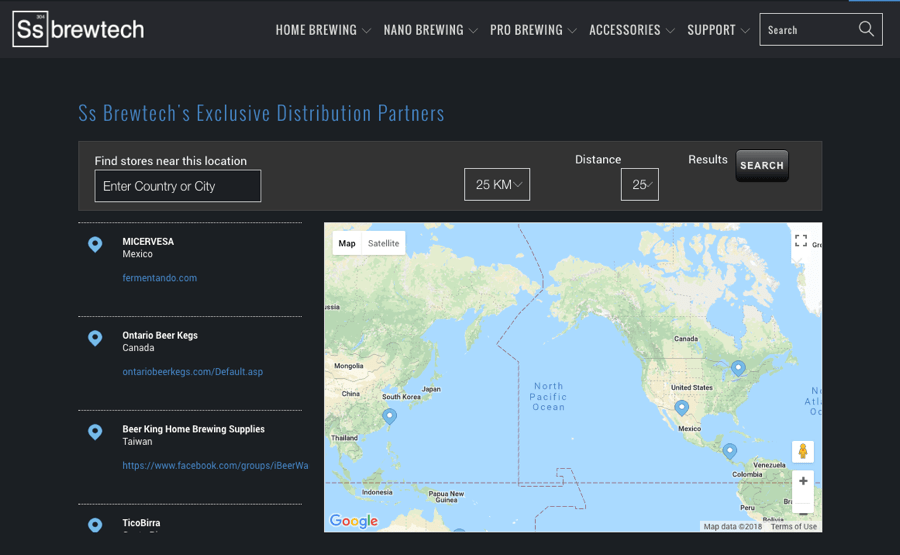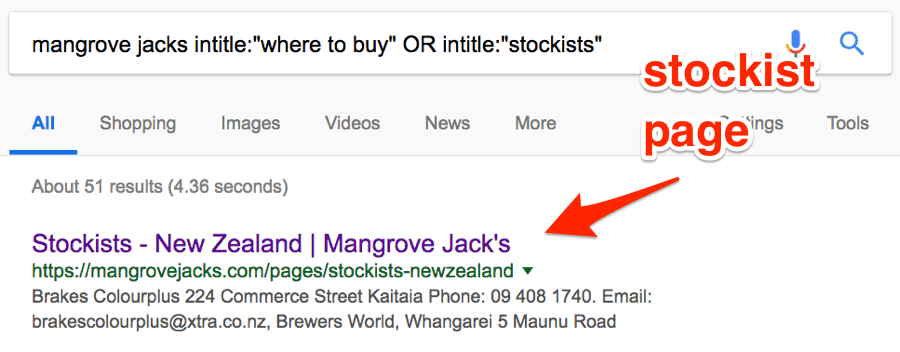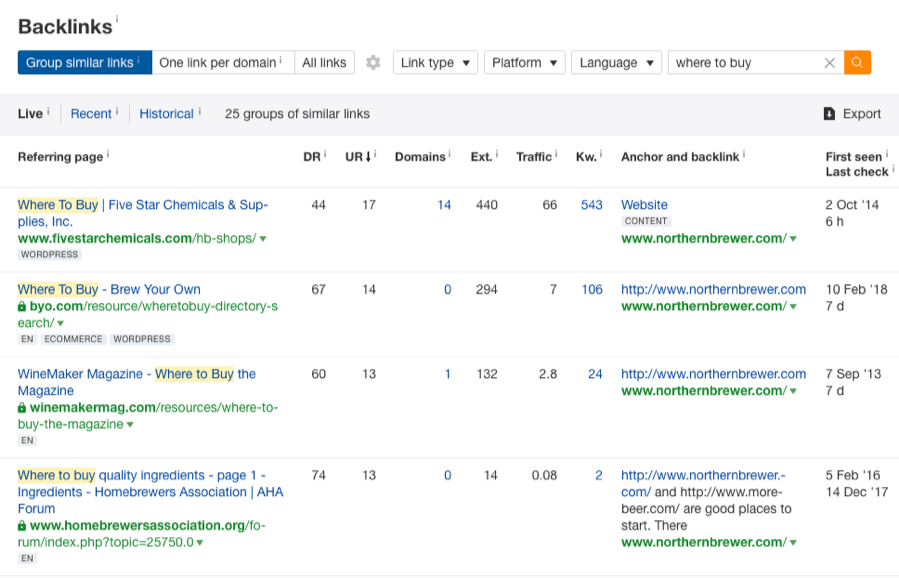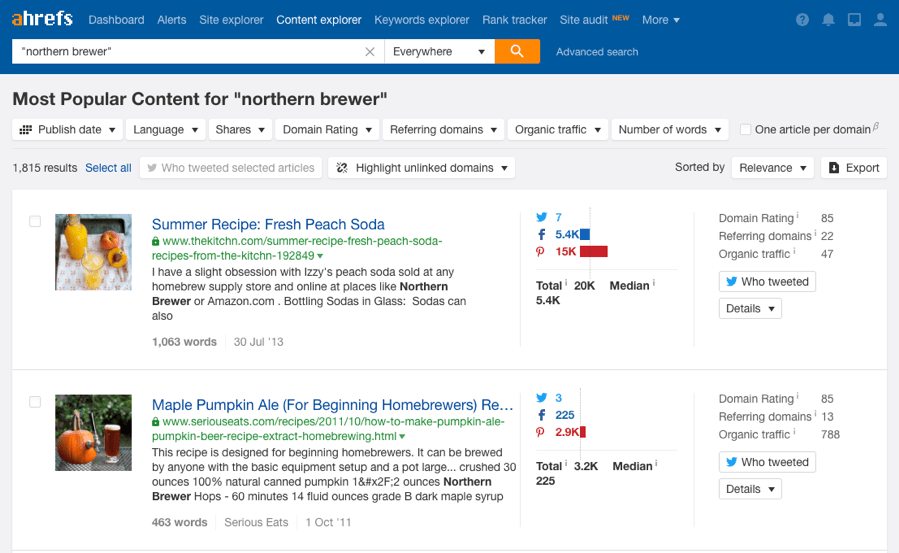Table of Contents
The SEO manual will help increase the number of online shop visitors and increase your sales. Just follow our manual step by step.
A lot of people do SEOs with a misunderstanding of focusing on the number, or volume, that it has to be very high to be above the competition.
To put it more concretely, suppose you sell men’s clothing, the following keyword “mensclothing” chart shows that you are focusing on the search peak (Volume).
Estimate the volume of the keyword “mens clothing” from the American monthly search based on Ahrefs Keywords Explorer.
And let’s take a look at some of the top-ranked websites down here.
Do you think you can bring these sites down? ? I have to say, possibilities are zero, so you’re probably wondering if this is what you’re going to do. What Can Be Defeated? The answer is to focus on the right kind of products, and focus on which websites are the least competitive.
This manual will tell you every step of the way from beginning to end.
Let’s get started! !
First thing to do is go to https://ahrefs.com/site-audit and find all the Errors on your website. Watch Sam Oh explain what to do with the video below.
You might think you don’t want a lot of the results of this, but you’re going to want it, but since all of these settings are going to take quite a while, it’s recommended to start doing this first.
Let’s check it out together.
If you’re currently running an online store, your website will need HTTPS. If you look at multiple websites, you won’t believe that many online stores don’t use HTTPS.
Is HTTPS that important? It’s very important, because almost every online store has a user’s personal information, so securing this information is just as important to protect it as credit card information.
And Google insists that the website is rated by HTTPS. Although it doesn’t have that much effect, it’s one of the reasons you should check.
E-Commerce SEO Guide How to Set Up Correctly
Let’s get started! !!!
Part 1 – Searching for online store websites via Keyword Search
The same approach as any SEO campaign is to start by searching for the Keyword, without these Keywords, it’s like being blind, because how do you do SEO? Direction, based on emotions, feelings, and the SEO campaign, which is useless.
How do you create a Keyword to find a store? What?
It’s actually very simple.
1. Write down all the pages you have on your Web site.
2. Find a word, or write out a word appropriate for each page.
Tips: If you don’t have an online store, read through this guide, there’s a trick set up for you to follow.
And of course, every time you do your homework, research the keyword according to the content of each page.
And this is a highly recommended way to do it. No matter how many websites there are, for websites that are for online stores, the homepage or homepage is divided into two main pages: (1) category page and (2) product page.
Each page has a slightly different procedure and methodology, so where do we start?
1.1 Write down the names of all the URLs and webpages of your website.
By going to your website URL /sitemap. xml
When you’re done, it looks something like this.
If you can’t find your map or sitemap from the currently used URL, go to your website URL/robots. This page will display your sitemap URL.
If you see a file with a last name. gz let’s delete it like sitemap. xml.gz, let’s just subtract out the sitemap. xml The web site will download sitemap instead of displaying it on the browser.
Use the Scraper plugin (Chrome) to extract a list of URLs using XPath as //a[containers(text(), » {your siteName}“)]/@href
If you do not have your own online site, only follow the above with the existing competitor site.
Then you can start looking for the keyword by looking at the competitor’s website structure, categories, and products.
To find the right website, visit https://ahrefs.com/keywords-explorer and enter keywords related to the product you’re thinking of selling. Make sure you choose the right country.
Go to the left-hand menu, then select “Traffic Share” and go to “By Domains”.
The image above shows which domains are most visited by the search for the keyword that you search for.
You can select 1 Domain from here (try not to select a very famous brand) and then follow the steps above to extract the sitemap.
Then copy the results to the Google Sheet.
Knowledge: Getting started on a competitive website saves you time searching for a list keyword and also helps you to select categories or claims that are not relevant to what you will sell.
1.2 Prioritize each page
So basically, we encourage you to research the keyword from page to page, which we know is what you’re thinking.
« There’s a lot of pages on my website. Do you expect me to be able to put in all the keywords and adjust the content one page at a time like this? »
We really hope so, but we also understand that it may take forever to complete, so we’ll tell you the trick that helps you finish faster.
Is to adjust the most important page first.
If you install Tracking your online store with Google Analytics, you can get a better picture of which page is most important by going to Behaviour Site Content Landing Pages short by revenue (high to low).>>>
Let’s break down the report category and see how many people actually visited in the search.
Or you could also use the same report and separate it out for « by traffic (session) ».
But if you don’t have Google Analytics installed, if possible, you should. Or you might just want to find out about your competitor’s website (because you haven’t started installing online stores), try Ahrefs’ https://ahrefs.com/site-explorer page at the top by going to Site Explorer, entering the Domain, going to the Top Pages.>>
1.3 Search and write out the Keyword of each page.
Now that you have a list of pages that you’ve rated as important, you can start to find or write the Keyword of each page. Keyword to write, for example:
- Keyword (e. g. Keyword that you want to enter to find that page)
- Long Tail Keyword, a specific search word, like any word you see that it will draw more people to this page.
Let’s start with Head Keyword.
First, find the Head Keyword or Keyword.
Believe it or not, just because you search the Keyword you already have in mind, that’s the best way to find the Head Keyword. You can find it at https://ahrefs.com/site-explorer .
To see more, let’s look for a keyword for the Grainfather business, a business that deals with beer fermentation from the top of rice.
Go to Site Explorer, paste the URL into Organic Keywords>>.
When searching Site Explorer, set « URL », which is located at the drop-down option.
Notice the keywords that go up (from the figure above) the word « Grainfather » (who used to search 2.9k a month) topped every keyword on this page, and ultimately the word was the word that made us sell.
But let’s click on the SERP drop-down and look at the top 10 web pages, and check the following two.
- The ranked web page is now information about What? Product information? About product categories? Is it Blog? Or is it something else? This is important because this information will allow you to find the right keyword as you want. If you see that the top 10 pages are all up in the blog, you don’t have to enter keywords about product information or product categories to waste time because it doesn’t work because people don’t care right now.
- Look for the top search keyword. We have a list of keywords that are frequently searched in the SERP Overview menu. You may also find a duplicate of the top 10 web pages, which may be in duplicate with the keyword you are thinking of entering as a header. However, sometimes trying to search for top keywords. And from here, there’s another way that you can find more head keywords.
So let’s do it this way.
From the figure above, the observations obtained are as follows:
- The top three are Grainfather’s main web pages, and we’re definitely not going to put this page on the bottom.
- 86% of the results are information about the E-Commerce business type or the product page. This is a good sign, because it means people are looking at this page and looking at this page.
- The most frequently used keyword is « brainfather », so this is a very good word to use the header keyword.
After seeing that it is appropriate that the word is a head term for this page, put it in your own spreadsheet.
A tip if you can’t do that? Let’s see how this works.
Sometimes things aren’t always easy to understand. Let’s take an example from the Organic Keywords report shown below from http://www.asos.com/women .
We’ll see that not only is there more than 4,000 keywords displayed, but you’ll also see that there are a lot of keywords searched with brand names, and there’s a very small number of keywords not found with brand names, but there’s very little search like the word « Woman store ».
All the keywords from the picture above, none of the words can be used as a head term, so what we can do is as follows:
- Write down the Organic Keywords by Number of Searches (Volume)
- Search for the right words to be the head term or the main keyword of this web site (make the most of your ability).
- Check the list of words you have at SERPs and see if most of the ranked web pages are information about the product or product category. (If you can’t find the words listed, try other words.)
- Find a web page that looks like yours on the SERP Overview that is most visited by people.
- Browse to the Organic Keywords page.
- Repeat from the first step down.
The short GIF file below shows a demonstration of steps 1,2,3,4,5.
Step 2 Find a specific search word (Long Tail Keyword) and related search words.
This type of keyword can be found in several ways.
For beginners, Organic Keywords are a great collection of search terms for specific keywords or related keywords. Just remember whether the words you search for from SERP are similar or related, such as Top Ranking, are related to E-Commerce or product classification.
Then add any words you see fit into your spreadsheet.
But then again, this report might have a lot of information, which, like this, we have some techniques to help with.
By going to https://ahrefs.com/keywords-explorer and then entering the head term, go to SERP Overview.>>
Copy and Paste the web page ranked 3 – 10 about the product or product type page on https://ahrefs.com/content-gap and set the values according to the below.
- Leave the « But the following target doesn’t rank for » blank (for now).
- « At least one of the targets should rank in top 10»
- Select « at least 2 of the below targets » from the « Show keywords that _ rank for » drop down menu
The result should look like this
This method not only helps you find multiple keywords, but also helps you find multiple words with similar meanings to put together, such as « all on one brewing system »
Then put the words you find into your spreadsheet
Then repeat the process for each page of your website
Part 2: SEO on the website
Now that we have found the keywords and terms to optimize for each page, we need to start using the information we have found
2.1 Customize Meta Titles, Descriptions, and H1
Most E-Commerce websites use a template to describe their Meta Tags. It should look something like this, as shown in the image
The simple reason many websites use a template to write a topic instead is because it has many pages, from ten pages, sometimes hundreds or thousands of pages on the website, and writing a topic or content that does not use a template or think and rewrite each page. It’s a tedious task that makes you hallucinate.
But the problem is,
Using the template as defined should not be done. By selecting this, we will not be able to customize the text on each page of the website.
Because of this, we recommend trying it this way instead.
Try to use all the effort you have, write out an adjustable tag for important pages, and then apply the template to other secondary important pages.
Still, we do not recommend using the same template on every page of the website. You want to create your own template for each page, whether it’s a product type page or a product type page, or a brand name, etc.
For example:
Malt Miller sells « Hops » 85 different kinds of seeds and is sold in 100 grams of vacuum flushed nitrogen envelope.
Below is a brief description of the topic and a description of the content satisfactory for each product of this type of product.
Buy {HOP NAME} Hops (100g) — Vacuum Packed for Freshness | The Malt Miller
Buy (Product Name) Seed « Hops » from The Malt Miller – Free shipping All HOPS seeds we sell, vacuum-packed for freshness, delivered the next day after receiving the order before 1pm sharp.
And the example below is a description of other different products that should come out.
Buy Citra Hops (100g) — Vacuum Packed for Freshness | The Malt Miller
Buy Citro hops at The Malt Miller – Free shipping of all the HOPS seeds we sell, vacuum-packed for freshness, delivered the next day after receiving the order before 1:00 p.m. sharp.
Buy Centennial Hops (100g) — Vacuum Packed for Freshness | The Malt Miller
Buy Centennial Hops at The Malt Miller – Free shipping of all the HOPS seeds we sell, vacuum-packed for freshness, delivered the next day after the order is received before 1:00 p.m. sharp.
You might need to write out different templates for use with different products.
But like I said, you should rewrite your own explanation for any web page you see as important.
The question is, which is the most important page now, which is the most important page, which is the one with the duplicate keyword and which is the top 10 list?
So, filter out these keywords, put your spreadsheet, and get your job started.
The following is important not to overlook.
- Add key keywords.
- Use a variety of specific keywords (must look appropriate for that context)
- Add action words such as Buy Now, Click Now, See More, Sell Now, Free, etc.
- Tell me how to ship your products (free shipping, next day shipping, free return, etc.)
- Configure the CTR that makes people want to press.
Hands-on intelligence: Experiment with topic descriptions and content descriptions in a separate format (for example, add more product prices) to increase the number of people pressing in.
So H1 is What?
H1 or Big Topic 1 is easy. Just write the topic for that category of goods (on the product category page) and write the topic for that product (on the product page).
If you’ve done these homework, the H1 topic you’re going to use comes from the keyword you want to focus on.
So there’s no need for this part. What’s complicated just to be careful that you write H1 on every page of the Web?
2.2 Customize Your URLs
Most e-commerce site URLs can be confusing, such as the one from the topshop below.
www.topshop.com/en/tsuk/category/clothing-427/t-shirts/N-82zZqz6Zdgl
This irregular url should be avoided. You also want your URL slugs or permalinks to be as clean and easy to read as possible.
So this is the first thing you want to do.
– domain.com/ Product category name (on the Product Category page)
– Name domain.com/ Product Category Name/Sub-Product Category Name (on Sub-categories page)
– domain.com/ Product Category Name/Sub-Product Category Name/Sub-Product Category Name (on Sub-categories page)
– Name domain.com/ Product Category Name/Sub-Product Category Name/Sub-Product Category Name/Product Category Name (on the product page)
Easier than you think, right? And?
A few tips, you can see that the data management system has been messed up by default, for example, « WooCommerce adds / product categories / URL to every product category page, which makes it even more complicated and contains plugins, suggesting that you can eliminate this problem, but honestly, it is sometimes disturbing instead of helping it get better sometimes. So our advice is not to worry too much about it unless it’s starting to look messy.
Examples from The Malt Miller:
- com/ingredients/(category page)
- com/ingredients/hops/(subcategory page)
- com/ingredients/hops/whole/(sub‐subcategory page)
- com/ingredients/hops/whole/citra/(product page)
Try to keep your eyes clean, like this looks okay.
- com/ingredients/hops/best‐citra‐hops‐2018/
This might look like a URL snug for a blog post, which might cause no clicks to come in.
Maybe choose to look something like this.
- com/ingredients/hops/whole‐hops/whole‐citra‐hops/
Repeating a word like this has no effect on making SEO, but it’s even more disturbing.
Here are some more tips on how to write E-Commerce URLs effectively.
- Try to be as concise and non-strict as possible.
- Enter the key keywords.
- Clarify page priorities and page contents
- Use the (-) symbol to separate words. Do not use underscores, spaces, or other characters.
- Which part doesn’t need to avoid using URL parameters?
2.3 Write product descriptions and product categories with your own words.
Take a look at a number of famous retailers, and you’ll see that they put a self-written description of the product categories on the pages.
And on the product page.
Camis & Vests page from the Topshop brand.
Broderie Trim Camisole Top product page from the Topshop brand.
There are two reasons why brands do this.
- This type of writing helps people who visit this page to know the products or categories they visit.
- Writing like this helps Google better understand what this page is about. What?
Remember, Google ranks web pages from the algorithm. If there is no description of the content on the web page, it will make more sense.
It’s hard for the algorithm to understand us.
Therefore, it is recommended that you add your own annotations to the Product Category and Product pages.
And by “let you write it yourself,” that means it has to be you writing it yourself that’s really unique and really different.
Do not copy and paste product descriptions from other websites for you to write them yourself.
The following are recommended guidelines.
- Add the main keyword you want to target in the description.
- Put several scattered words in a similar meaning and a similar meaning keyword.
- Words written down to the visitor must be able to read and understand.
- Try to send a message to those who visit the page what they would like to know from it.
- Don’t be distracted. Try to keep the explanation brief and not look stiff.
If you think that every single page of this writing makes you feel so much that you want to cry, it’s recommended.
Try to start with the important tasks.
Knowledge: There are many e-commerce stores sold on Amazon and using the same product description on every platform as well. Think about what form would make the most of the rankings.
2.4 Enter « Schema Markup » to add.
How would you like your product page to be displayed on SERPs?
Sounds like a mindless click, doesn’t it? ? Not only does the background image (with Schema markup) look like it’s going to be more interesting, it’s going to help searchers get more information. It’s going to add up to 30 percent more people to click on it.
This means that the number of people visiting the website is increasing, so they can sell more things.
Furthermore, Google reads this information to better understand the content of your web site (such as a product page or a product category page or blog page, etc., which is very important for doing E-Commerce SEO).
But Schema markup can be a little bit complicated, so let’s start with the basics.
Product Page
« Add a markup on your product page. Google will be able to display detailed information about your product when someone searches for it, and when people press for a photo, they will find it. The price, status, and rating are reviewed by typing ».
Webmaster Guidelines, Google
You can follow them from https://schema.org/Product .
There are several features that you can add to the schema properties page, but the following are the most popular terms and we recommend adding them if they are product web pages.
This is what it looks like.
Grainfather – All in one brewing system

Rated 4.3/5
based on 11 customer reviews
$1,000.00
In stock
Product description:
The Grainfather is an all-in-one all-grain brewing system. It’s great!
For Category Page
The Product Category page is a page that represents a different product or recipe, video, or other format. Each category should be marked up using a schema. Org Related Types such as schema.org/Product for Product Categories page If one of the products is marked, all of the products must be marked. Similarly, this is a linked category. Marking each product should not be tied to a non-uniform detail page ».
Webmaster Guidelines, Google
Are you confused? ?
You can interpret it by understanding, but here’s what we’re suggesting by interpretation.
- You can mark up more than one product on one web page.
- In case you mark up one product already, you have to do this to all products.
How? However, in the product categories page that Google makes do this, it should also help Google decipher the type of page in that category.
You might not see how much information is displayed on SERPs for the Category page.
And therefore, for simplicity, we recommend that all pages be marked up as category pages.
Knowledge If you use breadcrumbs on your web site (which we recommend you use), you can also add Schema markup.
Google says this:
«Google Search uses breadcrumbs makeup to find information and categorize that page’s information from the body part of the web. Therefore, information here will be displayed when searching ».
Part 3 Technical SEO for E-commerce sites
E-Commerce websites tend to cause SEO technical problems more frequently than others.
This section, we’ll briefly explain what the problem is. What and how?
I have to say, this part is a little bit more relevant to the data or the numbers from Site Audit, so if you’re ready, let’s get started.
3.1 Resolving the problem of reproduced content
https://ahrefs.com/site-audit > internal pages > content quality
And then you’re going to look something like this.
A little confused, don’t you think? But I’ll explain it to you.
This green, orange, tile-patterned image shows a collection of duplicate data on your Web site.
This green tile is not there. What’s there to worry about? What? So now we’re not going to care here, but because the orange color represents a bunch of duplicate data, we’re going to care about it here because it shows that there’s a problem here.
So, click on each piece of orange tile and see if it’s an orange tile. What?
Notice that two pages appear on the browser tabs below as GIF files that we alternately press to see how different they are.
Can you find the difference between these two pages? ? That’s right, we can’t find it either, because these two pages are exactly the same.
These are the URLs for both pages.
- https://www.spoiledbrat.co.uk/collections/new-arrivals/products/i-scream-nails-pink-limousine-nail-polish
- https://www.spoiledbrat.co.uk/collections/womens-wear/products/i-scream-nails-pink-limousine-nail-polish
Note that the difference between the links above is where the highlights are made.
In fact, these two pages should not be visible, so delete them and send one of the two pages to another page instead.
But sometimes, having two web pages similar to each other may make sense, too.
And if so, canonical link is your best friend at this point, because it helps you ensure that Google indexes from just one page.
You can also add « noindex, follow » to the Meta Robots Tag.
This is a tip that Google wouldn’t ignore if it found this tag.
Adding a noindex followed by a meta robot tag to your problematic web page helps you ensure that duplicate data is edited out of the metrics as soon as Google browses the web and finds it. That means you do this, you don’t want Google to index it from here.
So don’t block web pages through robots. txt until the page disappears manually from the index.
After that, you can block it to make sure that it’s safe.
- These duplicates won’t come back.
- You don’t have to lose your claw equity.
เกร็ดความรู้ เพิ่ม meta robots tag เข้าไป จากนั้นตั้งค่า « noindex, follow » ทุกหน้าที่เกิดปัญหาขึ้นบนร้านของคุณศึกษาข้อมูลเพิ่มเติมเรื่องวิธีการใช้ meta robots tag สามารถเข้าไปดูได้ที่ YOAST
Knowledge Base, add a meta-robots tag to it. Then set « noindex, follow » All pages that have problems in your store. For more information on how to use the meta-robots tag, visit YOAST.
3.2 Unable to find the problematic page, click back to the home page.
If you want to make it easy for people to visit our category page or products on the web, the general rule you need to know is never allow a Home page or a Home page to access poor content more than three or more times.
A good structural model should be = homepage categories subcategories products.>>>
Bad structure format will be = homepage category caegory etc.>>
However good this rule is, especially good for e-commerce websites, it’s not possible.
It’s always been possible to actually apply this rule for a relatively large site.
So the rule that we see better is this:
Verify that important web pages must not have more than three clicks to return to the home page when clicking Enter from the home page.
First time in.
But how do we figure out which page needs to be clicked on and how many times to find it?
Go to https://ahrefs.com/site-audit data explorer depth is greater than 3 Is valid (200) internal HTML = Yes>>>
Let’s just say it’s definitely worth checking these pages and restructuring the internal linking.
Click Back to Homepage. There’s no need to click too much.
Here’s how to find a problematic page like this (a page without internal links pointing back to that page).
https://ahrefs.com/site-audit > Data Explorer > Inlinks = 0 > Is valid (200) internal HTML page = Yes
There are 398 pages in total.
So let’s just say it’s definitely worth a sit-down.
Tips like pros, focus on pages that can’t be classified as metrics because these pages are pages that affect SEO.
3.3 Look for Keyword Cannibalization Errors
« The cannibalization keyword occurs when a site, such as web ahrefs. com failed to group the same keyword from multiple posts or from multiple Web pages »
Joshua Hardwick Head of Content, Ahrefs
This is a problem that many E-Commerce websites encounter, especially older ones, and this is a way to find and solve the complete keyword cannibalization problem.
Part 4 – Link process from other websites to link to our website for E-Commerce website.
Linkage from your homepage, product page and product category page is a technique that is rarely seen as good, but even so, it’s not a bad thing. What if it’s that hard for you, it’s hard for your competitors, which, in doing so, makes it less likely to top your website, but you still need your links on other people’s websites, so there’s a lot of ways you can do it.
4.1 Find Sites Linking from your competitor’s Homepage
Imagine how great it would be if there were a way to find a website that could connect to your competitors’ pages, which would be great if you could do the same for your website, right? Of course it is! Here’s how it’s recommended.
Go to https://ahrefs.com/link-intersect . Enter the name of the competitor’s homepages.>
Select the « URL » for all websites to enter drop-down because it means you will only see links to the home page.
Recommendation if you’re not sure who you’re creating a link from your competitor’s web board comment. Go to https://ahrefs.com/site-explorer , enter your domain, enter your opponent’s domain.>>
It is recommended to add a few competitors, then start by selecting « any of the low targets ». The link intersect will show which Web sites are linked to your competitors. All you have to do is find the results that can be identical to the same source, for example:
Forums :
Link Page :
And because these sites can be linked to competitors’ pages in many ways, it’s very easy to link to you.
4.2 Go to the « Where to Buy » page of the production company.
Many manufacturing companies have web pages that look something like this.
It’s a list of stores that are kept online and offline, and they also have a web connection to the list.
One way to find this page is to find the brand that you store on Google, followed by the {manufacturer product(s).
You stock} and enter the inside title “where to buy” ORintel: “stockists”
Then check the relevant output and see if there’s a list or a link to the stock page for anything like us. If available, visit the page and send a request to add the product.
>You can also use ahrefs by going to https://ahrefs.com/site-explorer to enter your domain to compete in Backlinks.>
Then search for words like « stockists » or « where to buy » on the search field.
If it is associated with us, visit the page and submit a request to add it.
4.3 Techniques for making « International Alternative »
How does this work? Let’s do it.
- Find competitors in different markets, such as competitors sold in the U.S., if you’re in the U.K.
- Find a blog that has been written, discussed, or introduced about your competition.
- Ask them to put a link on your page, make it look like « could be useful to readers on the British side, too. »
Let’s take an example of the Malt Miller brand.
The brand sells beer brewing equipment and is sold in England, while Northen Brewers sells beer brewing equipment and is sold in North America.
Once the information is available, let’s find a blog that introduces Northern Brewer and see if there’s any content in it that can be pasted. We can give readers more ideas to read to add more country options.
https://ahrefs.com/content-explorer > « from {brand} »
The figure below shows the results of a search for the word « Northern brewer », with a total of 1800 results.
Not all results displayed are related. There may only be some results that are related.
For example, the figure below is a blog post about talking about cider curing, and there’s a link pasted to Northern Brewer: and it’s a very well-written post about the cider curing process, ingredients, and devices that you need to use.
But for readers who come from England, if they hit the website, they go to a destination that didn’t send them to England, because…
Therefore, as an additional alternative to readers who may come from England, it may be helpful for this blog and readers of this blog as well.
Here’s an example of another page.
The story is similar and links to Northern Brewer and amazon are given. com as well, which is not very useful for British visitors, for example.
It’s easy to paste links from other websites, so you just contact them and ask them to add links to them as an alternative for readers from the UK of the page.
Here are some examples of emails you can write to send.
Hello [name]!
I’m George from The Malt Miller.
I came to read the cider instruction manual that you wrote and noticed that you had a link to Northern Brewer.
I’ve been in business [for a number of years], and I know that Northen Brewer is one of the good equipment companies you’ve been talking about.
(Device name) But sadly, that place didn’t go to England.
How? Well, we’re selling the same stuff in England, so I was wondering if you could consider adding us to the list.
The same post as Northern Brewer, would you? Well, I think it might be helpful for your English readers, too.
Anyway, tell me.
Thank you. !
George. Josh.
Let’s do this once or twice more, and we’re sure you’ll be able to paste a link to some posts.
The trick is up to you how white-collar you are, because these processes are really white-collar, but I’m sure you’ve figured out a creative gray-collar or black-collar link that’s all we can say, because we don’t support black-collar, because it’s kind of risky, but that’s your choice.
Section 5 Write marketing content for E-commerce sites.
As mentioned earlier, linking links to product categories or product pages may be too difficult, which is because very few people want to paste links. Truthfully, it’s easier to market and paste links on their informative content pages, such as blog posts, infographics, tools pages, etc. But doing this for E-Commerce is quite a small amount of sales.
By saying, you can write content to increase the page rate (Products and Product Categories page) on your E-Commerce website.
The message from the author, for this section, is another example from The Malt Miller.
5.1 Write something that « is worth clicking on. Read ».
The first thing to do is you need to write a content that’s relevant to a particular marketplace, and if you want to read it, it’s a source of knowledge that can help you, but because we want this guide to be as practical as possible, we’ll tell you the techniques of how to get people to link.
I’d like to share it with you in your niche market.
Go to https://ahrefs.com/content-explorer . Enter keywords related to your specific marketplace filter for pages 100+referring domains.>>
Then, based on the results shown, select the page most relevant to your particular market, such as calculating beer brewing.
This page has 128 citations of this domain, and that means a lot of people have gone in.
Once we’ve got the past content ideas that are both relevant to our niche markets and attracting a lot of links, it’s a simple process to write something similar, and actually better, and then you can use the instructions below to promote and create links for it.
5.2 Add internal links strategically
Now that you’ve got a content that’s going to give you a piece of information that’s going to draw you a link, the next step is to do an internal link from one content to several content that you want to push.
Which we would suggest this way:
- Make sure that the page you’re going to get him to link to is only a link to the corresponding internal page.
It would be strange if you were to link the story of brewing equipment to the content of brewing calculations, because people who can calculate them would have to have all of these equipment, but to do it, readers might need to know more about the ingredients. Therefore, it would make more sense to link the ingredients category page to this page.
- Link to product page or product category page
Remember, these are the pages you want to drive the most because they allow you to earn more money with your business. Connecting our own internal web pages or internal links to product pages or product categories will also enhance your position on SERPs.
For a more understanding example of this strategy, visit the Refractometer calculator from Northern Brewer. According to Site Explorer, there are 2000+ links from 74 domains that are referred to.
Which is probably why Why did Northern Brewer choose to link to category « Hydrometers & Refractometers » from the calculation page?
For more information, please note: Category « Hydrometers & Refractometers » page, rated #1 for « Brewing hydrometer »
The knowledge of this information is not the only reason his internal linking strategy is the main reason why this page ranks like this, but it is certain that knowing this information will be beneficial.
The last chapter.
This article does not offer a new version of SEO, but if you follow the long instructions above, we can guarantee that your website will outperform 90% of the competitors.



